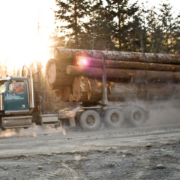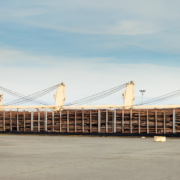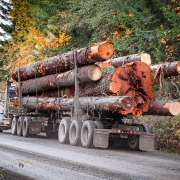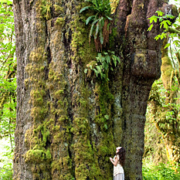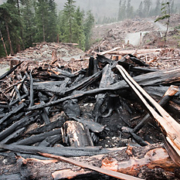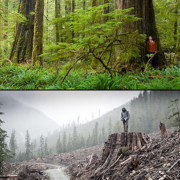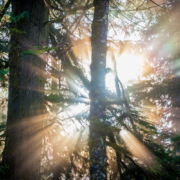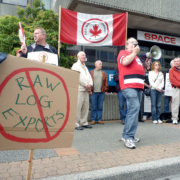Archive for month: October, 2010
Ban Old-Growth Wood and Raw Log Exports to China, Ancient Forest Alliance tells BC Liberal government on the Eve of Trade Mission
/in Media Release/by TJ WattThe Ancient Forest Alliance is calling on the BC Liberal government to ban old-growth wood and raw log exports to China on the eve of the BC Liberal government’s trade mission to China. Starting tomorrow, from October 28 to November 8, Pat Bell, BC’s new Minister of Forests, Mines, and Lands (formerly the Minister of Forests and Range) will be embarking with industry reps on the BC government’s largest trade mission to China so far.
“Having just come back from a trip to China, I’m more than convinced that expanding Chinese markets for BC wood without any significant export restrictions or regulations will turn out to be a first rate disaster for BC’s old-growth forests and jobs in our wood manufacturing sector,” states Ken Wu, co-founder of the Ancient Forest Alliance. “China’s monstrous appetite for resources, its enormous base of new middle-class consumers, and its vast amounts of cheap labour will virtually commit BC down a path towards eliminating our last old-growth forests, sawmills and wood manufacturing industries, should the BC Liberals continue to open up Chinese markets without any major regulations.”
For several years the BC Liberal government has been spending millions of taxpayers’ dollars to market BC wood products and to lobby Chinese authorities to change building codes in Chinese cities to allow for the construction of six-storey, wood-frame apartments, to promote wooden trusses on roofs, and generally to promote the use of BC wood for construction in a country where concrete, stone, and steel are mainly used.
Currently, several hundred thousand cubic meters of coastal old-growth hemlock and some cedar (4% of BC’s cedar sales) are going to China, as well as large amounts of interior pine, spruce, and fir. The BC government is expecting that a new record of almost 6 million cubic meters (2.5 billion board feet) of BC wood will be exported to China this year (see https://www2.news.gov.bc.ca/
In order to protect its own sawmilling sector, in 2008 Russia announced that it would implement an 80% tax on the export of raw logs leaving the country, which took effect in 2009. Seeing an opening in the Chinese markets which once relied on Russian logs, Forests Minister Pat Bell began a series of trade missions to China in 2008, which he stated was for BC “lumber, not logs”. However, in 2009 Bell approved the first set of raw logs to be exported to China by Coast Tsimshian Resources from BC’s northern coast. In 2009, the company exported 120,000 cubic meters of raw logs to China, Japan, and Korea. China is reportedly the world’s largest importer of raw logs.
“While in the beginning they’ve largely been purchasing BC lumber, which will keep some BC mills afloat, industry analysts have pointed out that China is really interested in BC’s logs – I suspect for the simple reason that purchasing manufactured products with North American labour costs added is less attractive to the Chinese than manufacturing the raw resource themselves for one-tenth the labour cost,” states Wu. “The BC Liberals opened the gates for raw log exports to China last year, despite their previous hollow assertions that their trade missions were for lumber. So in the not too distant future, I would be surprised if BC’s wood manufacturing industry doesn’t begin a migration to China, like so many other North American industries. BC workers will be able to thank Pat Bell and the Campbell government for facilitating this.”
Old-growth forests are important for supporting species at risk, tourism, the climate, clean water for salmon and people, and many First Nations traditional cultures. 75% of Vancouver Island’s productive old-growth forests have already been logged, including 90% of the valley bottoms where the largest trees grow.
See “before” and “after” maps of Vancouver Island’s remaining old-growth forests at: https://www.
See SPECTACULAR photo galleries of Canada’s largest trees and stumps at:
https://www.
The Ancient Forest Alliance is calling on the BC Liberal government to:
– Protect BC’s endangered old-growth forests
– Ensure the sustainable logging of second-growth forests, which now comprise the vast majority of the forested land base in southern BC.
– Ban raw log exports to foreign mills to ensure a guaranteed log supply for BC mills and investors
– Provide assistance and incentives for the retooling and development of value-added mills and wood processing facilities to handle second-growth logs.
“There’s nothing wrong in principle with selling BC wood products to China. However, because it is such a huge market with so much cheap labour, we have to regulate our exports there to protect BC jobs and our environment – starting with a ban on old-growth wood and raw log exports,” states Wu. “Without the needed controls, the BC Liberal government is committing BC’s economy to a deeper path dependency on old-growth liquidation and raw log exports, which will result in the demise of our last old-growth ecosystems and thousands of BC jobs in the wood manufacturing sector. Who the hell wants that?”
ANCIENT FOREST ALLIANCE CALLING FOR BAN ON EXPORT OF RAW LOGS TO CHINA
/in Announcements/by TJ WattB.C.’s new Minister of Forests, Mines, and Lands, Pat Bell, leaves tomorrow for a trip to China to talk lumber.
Not everyone though sees the potential business as good for our province. Co-founder of the Ancient Forest Alliance, Ken Wu, sees problems ahead.
“He’ll be embarking in the largest trade mission in B.C’s history to China so far along with 30 industry representatives. We’re calling on the B.C. Government to ban the export of old-growth wood and raw logs to China. Otherwise we’re gonna be essentially losing our jobs and the quality of our environment.”
China relied on Russian logs untill last year when Russia implemented a 80% tax on raw log exports to protect their own sawmilling sector.
Canada’s Largest Spruce Tree – The San Juan Spruce!
/in Announcements/by TJ Watt
Seen here is the San Juan Spruce tree. It is Canada’s largest Sitka spruce tree and the second largest in the world! It grows on Vancouver Island alongside the San Juan River about 35 minutes from Port Renfrew, BC. The towering tree measures 38.3′ in circumference, reaches 205′ tall, and has a crown spread of 75′. By volume it contains 333 cubic meters of wood which is equal to 333 telephone poles!
Despite all of this the tree and surrounding forest has not been afforded any legislated protection from the BC Liberal government. We are calling on the province to protect the area of forest, both old-growth and second growth, from the San Juan Spruce to the nearby Red Creek fir.
GPS Location for the tree is:
lat = 48.5879222222,
lon = -124.186630556
Clearcuts blamed in First Nation flooding
/in News Coverage/by TJ WattKINGCOME INLET – Clearcut logging and a receding glacier were pinpointed Tuesday as probable contributors to a devastating flood which swept through the remote First Nations community of Kingcome Inlet last month.
Indian Affairs Minister John Duncan and First Nations leaders, who converged on the village to take a first hand look at the damage, said a helicopter trip up the Kingcome River Valley was startling.
“Right at the glacier is an obvious unravelling of the slopes,” said Duncan,
who announced financial help adding up to $770,000 and said a key part of
the recovery plan will be a full hydrological assessment of the valley.
“I was expecting to see a significant event. What I wasn’t expecting was to
follow mud all the way to the headwaters and major, significant issues at
the head of the glacier,” said Duncan, adding that there will be no quick
fix.
Assembly of First Nations National Chief Shawn Atleo said the situation up
the valley means the community will remain vulnerable.
“It has been severely impacted by decades of clearcut logging and, at the
head of the glacier, I saw a torrent of mud and debris,” he said.
Increased monitoring will be necessary once residents return to the village
and one of the priorities will be ensuring the helicopter pad is usable at
all times, Duncan said.
Helicopters provided the only way out for about 120 residents when water
quickly rose up to four metres in parts of the village.
Wayne Goodridge, a pilot for West Coast Helicopters, the first to fly in
amid the flooding, said water was rising so fast it was uncertain whether
the helipad behind the school would remain usable.
“It was up to almost the top of the helipad – almost 15 feet. If it had gone
on any longer we would have been plucking them off the rooftops,” he said.
Apart from a handful of members of the Dzawada’enuxw First Nation who stayed when the water rose, most are now evacuated to Alert Bay, where residents are staying with friends and relatives.
In Kingcome Inlet, porches and steps have been knocked off homes, which are built on stilts to withstand regular, smaller floods. Mud fills crawl spaces and propane tanks lie at drunken angles.
Even though many electric meters were underwater, power has stayed on and Tuesday, as assessors and electrician pored over wiring and looked at other safety issues, Duncan said repair work could start on many of the homes.
“The sooner we can get people back in the community the better we will be.
Band council chairman Joe Willie said that although people are anxious to
get home, he is not yet sure it is safe.
Willie said he is pleased with support being offered by the federal
government, but the immediate offer of $100,000 for assessments and social
services help and $20,000 per house is not likely to go far. “We are an
isolated place and it costs a lot of money just to get materials in,” he
said. “Only one barge has agreed to come up the river. The rest wouldn’t
risk coming up the river.”
Although the river level has dropped, debris has collected in different
areas, creating hazards for boats. The small boats travelling the muddy
river take passengers to an open area of Broughton Archipelago to get on a
larger vessel.
The federal government is investigating building a road into the area and
about $900,000 has been spent on engineering costs, Duncan said.
Others would like to see logging companies, which have taken so much out of the area, help pay for some of the flood costs. Dave Darwin, who looks after Kingcome Inlet’s power, said the valley bottom was first stripped of all its old growth trees and then logging companies clearcut beside the main river and the tributaries. The river can no longer meander as it used to, he said.
“Maybe we can get some environmental group to finance a lawsuit,” he said.
Chief Bob Chamberlin, Musgamagw-Tswataineuk Tribal Council chairman, said the provincial government has some responsibility because it oversees
forestry. “The provincial government has enjoyed unlimited revenue from this place with no return to the First Nation that holds title. I think that
would be an interesting conversation,” he said.
However, the immediate concern has to be those driven from their homes,
Chamberlin said. “It has been 17 days now and every day we wait it’s going
to get worse,” he said. “There are 30 children displaced from their homes
and their community and we need to make proper plans.”
Losing legacies in the cut block
/in News Coverage/by TJ Watt“They aren’t logging old-growth anymore, are they?” This is one of the most common questions I hear when I talk to people about protecting B.C.’s endangered ancient forests. The sad reality is that here in B.C., we are still cutting down trees that started growing at the time of the Battle of Hastings in 1066 and were already 500 years old when Columbus “discovered” North America. B.C.’s ancient forests — on crown, or public land, and in the most critical ecosystem types and wildlife habitat — are still being devastated by logging. The Ancient Forest Alliance — an organization that supports grassroots activists, including the Ancient Forest Committee here at SFU — has been exploring the back roads of B.C., finding unprotected groves and recently clear-cut valleys in order to raise public awareness about the continued logging of old-growth. Early this year, a fellow old-growth forest campaigner, exploring the Gordon River valley on Vancouver Island, found a valley-bottom cut block full of newly cut stumps, many of which would take over 15 people to surround! A forest that would have been like something out of a fantasy was destroyed in a few weeks, reduced to . . . well, probably matchsticks. This is going on as we speak in B.C.’s “back stage” — something so unthinkable that even when I am standing there talking about protecting old-growth forests, people will ask, “Protecting them from what?”
A delicate balance
Unlike the younger, second-growth forests that develop from tree plantations, old-growth forests, largely undisturbed by industrial logging, have developed for hundreds of years into complex ecosystems connecting many different forms of life. The trees vary in age and height and grow farther apart, letting sunlight in through the canopy to the forest floor, where a rich understory can grow and provide food and shelter to many species. Big mossy tree limbs provide tree-top nesting platforms for an old-growth dependent seabird, the marbled murrelet. Dead and decaying wood also provides habitat for many species, and mechanisms within the forest act to filter water and store atmospheric carbon, which, if released, would contribute to climate change. Stepping into an old-growth forest feels like walking into a natural cathedral.
The industry digs own grave
The other side to this argument is one we hear all the time: “Old-growth logging is necessary . . . forestry is the backbone of B.C.’s economy.” But although it certainly boosts corporate profit, old-growth logging does little for the forestry workers who depend on the industry’s sustainability for their livelihood. How could using up the last of a resource that takes many hundreds of years to re-grow — if at all — be sustainable? The majority of forestland on Vancouver Island and the southwest coast is second-growth, offering the potential for a sustainable second-growth industry in these areas. Yet the government foolishly adopts the rhetoric that old-growth logging is sustainable, even as they stand by the logging of Vancouver Island’s last 10 per cent of productive valley-bottom old-growth and last one per cent of coastal dry Douglas Fir old-growth. Ironically, the main threats to forestry jobs lie in the industry itself, including the overcutting and elimination of old-growth, especially in lower elevation, more accessible areas. Furthermore, as ancient forests are logged to extinction, most sawmills in B.C., designed for old-growth rather than smaller second-growth logs, are being shut down by the B.C. government rather than being re-tooled to accept smaller logs. This government’s support for exporting logs rather than re-tooling sawmills is basically supporting the exporting of jobs while requiring even more trees to be cut.
Logging of our ancient forests is a luxury that can’t be sustained. Companies are not committed to sustainable jobs or habitats — what they are committed to is short-term corporate profit, and our old-growth forests are the price we are involuntarily paying for that. The B.C. Liberal government is continuing to hand over logging rights to large-scale logging companies — basically, the right to convert our public land to tree farms, to devastate our ecosystems and deplete a crucial and unique resource. We have seen this happen so many times in history . . . the collapse of the Atlantic cod stocks to name just one instance. Will we stand around and watch it happen again?
Tricks with numbers
Pat Bell, minister of forests and range, recently announced that we have more old-growth now that we have had in the past! Should we be reassured that this government is working miracles by growing thousand-year-old trees in mere decades? Or should we wonder if something is fishy about the statistics behind this claim? The government has stated again and again that there is still plenty of old-growth left and that much is still protected. But what they are including in these claims of abundant old-growth and generous protection is low-productivity old-growth — the tiny alpine trees and shore pine bog trees that are old but tiny, and definitely not sought out for logging . . . at least not yet. Of course the government is not logging all of this low-productivity old-growth, and of course they can easily protect it without a thought to industry demands — do they need to be commended for this? Only about 10 per cent of Vancouver Island’s original, productive old-growth is protected, and only about 25 per cent of the original productive old-growth is left (10 per cent if we count only productive valley-bottom old-growth, where we find the biggest trees and most biodiversity). Basically, there is very little left, and much in need of protection!
Legacies in the forest
Coastal First Nations cultures in B.C. have to a large extent co-evolved and co-existed with coastal old-growth forests, and this ecosystem remains central to many First Nations peoples along the coast, for the uses provided by the trees themselves — for canoes and totem poles — and for the support old-growth provides to salmon and other species. While there is interest among some First Nations in logging old-growth forests in certain areas, many support land-use plans calling for increased protection for old-growth. For instance, the Squamish First Nations pushed the B.C. Liberal government to establish new provincial conservancies in their “Wild Spirit Areas” in the Elaho and Sims Valleys, and these areas are now protected through new legislation.
The last of the last
There were times in history when it seemed perfectly acceptable to look out across the land and claim that there was more than we could ever take. We are past that time. We should have learned by now — we have taken too much before, and we are still taking too much. This is not an issue of the environment versus jobs; it is an issue of survival versus corporate profit. Logging endangered old-growth is not sustainable for our jobs, our children’s jobs, our futures, or those of the next generations.
The fact that we are one of the only places on the planet that still has ancient temperate rainforests such as these is both a gift and a responsibility. While appreciating the beauty and ecological importance of these forests, we must also recognize the threats that they face, and the need to act for their protection.
What do we want?
The B.C. Liberal government has recently implemented new protected areas on Vancouver Island, amounting to around 10 per cent of the remaining endangered ancient forests on the island. This is an important first step, and one that should be commended. However, there is so little left in endangered areas such as Vancouver Island that we need to keep demanding that the remaining 90 per cent of the island’s endangered ancient forests be protected, along with sustainable logging of second-growth that makes up much of the rest of forestland on the island. As well, we need to ask for a provincial old-growth strategy that would inventory old-growth in the province and protect it where it is most scarce. Along with these demands we are also asking for a ban on the export of raw logs to make sure that as many jobs as possible are provided for the amount of wood that is cut.
We are not asking for a change overnight, but a guarantee of protection measures in the most critically endangered habitats (Vancouver Island, the Lower Mainland and the southern Interior), which would include specific timelines to allow for transitions in the industry to take place — from immediate protection in the most endangered areas to a few years’ transition time in other endangered areas.
A new campaign
The Ancient Forest Alliance is currently launching a 100,000 Strong for Ancient Forests and B.C. Forestry Jobs campaign, aiming to get 100,000 signatories calling for an end to the logging of B.C.’s endangered ancient forests and a ban on raw log exports. You can help to reach this goal by signing the online petition and downloading copies for others to sign, at ancientforestpetition.com
Tangible solutions
Solutions to issues as complex as this must be reached through a variety of measures. To reach these goals, we engage in actions such as petitions, public outreach events (like hikes or slideshows), rallies, and protests. We also encourage people who support this cause to engage with their political representatives and the general public. Let others know about this campaign. Write letters to your local politician, to Premier Gordon Campbell, and to the Minister of Forests and Range, Pat Bell. Writing letters and asking for change from politicians may seem ineffective, but politicians know that each letter represents hundreds of people who feel the same way yet don’t act. In fact, pressure to get with the program may be easier than expected, especially in certain political ridings around SFU. Two MLAs in Burnaby (MLA Richard Lee in Burnaby-North and Harry Bloy in Burnaby-Lougheed) are in power by only a few hundred votes (548 for Richard Lee and 696 for Harry Bloy). Public voices (especially from SFU students, many of whom are in their ridings) will have much sway on their fragile balance of power, and their readiness to enact such policy changes.
Ancient Forest Alliance seeks support
/in Announcements/by TJ WattCo-founders of the newly formed Ancient Forest Alliance Ken Wu and TJ Watt will host an informative and inspiring slideshow featuring spectacular photographs of Canada’s largest trees tonight, Wednesday, Oct. 6.
The presentation by Wu and Watt will include discussion of the stunning ecology and complex politics surrounding B.C.’s old-growth forests and forestry jobs, and slides of the Red Creek Fir, San Juan Spruce, Cheewhat Cedar and the newly discovered and threatened Avatar Grove. It will be held at Central Hall from 7 to 8:30 p.m. on Wednesday, Oct. 6.
Admission is by donation.
“Time is running out for our endangered old-growth forests and B.C.’s coastal forestry jobs,” said AFA campaign director Wu in a press release. “Salt Spring Island is famous as a hub of environmental consciousness — it may very well have the highest density of tree-huggers in North America! It’s a key place for us to build support and expand the campaign to protect our ancient forests, ensure sustainable second-growth forestry, and to ban raw log exports to foreign mills.”
The AFA says that to date, about 75 per cent of Vancouver Island’s productive old growth forest has been logged according to satellite photos, including 90 per cent of the flat valley bottoms, while only six per cent of its original, productive old-growth forests are protected in parks. Meanwhile thousands of forestry jobs are being lost as millions of cubic meters of raw logs are exported each year to foreign mills.
Common Ground: Newsbytes
/in Announcements/by TJ WattOn September 16, in a seemingly unlikely event, the Ancient Forest Alliance stood in solidarity with members of the Pulp, Paper and Woodworkers of Canada and the United Steelworkers union in Nanaimo as part of the ongoing fight to ban raw log exports in BC. AFA forest campaigner TJ Watt spoke alongside union officials Nanaimo MLA Leonard Krog and Nanaimo-North Cowichan MLA Doug Routley to the hundreds of workers in attendance, denouncing the export of raw logs and calling for the protection of BC’s threatened forestry jobs.
“Under Gordon Campbell’s BC Liberals we have seen over 60 mills shut down across the province since 2003 while raw log exports have nearly doubled,” said Watt. “It’s time to ban raw log exports in BC, to rejuvenate local mills and to once again provide secure jobs for the thousands upon thousands of forestry workers who have been kicked aside by this backwardspolicy…Exported logs equals exported jobs.”
The AFA believes there can be a solution that works for both our ancient forests and our forestry workers. “The BC Liberal government needs to stimulate investment in the retooling of old-growth sawmills so they can handle second-growth trees. With 90 percent of the most productive lands on Vancouver Island having already been logged, the future of this industry is in sustainable second-growth forestry,” says Brendan Harry, communications director of the Ancient Forest Alliance.”
It is inevitable there will be a transition to logging of only second-growth forests in the not so distant future as the remaining old-growth forests become decreasingly accessible to the coastal logging industry in areas like Vancouver Island and the southern mainland. The Ancient Forest Alliance calls on the BC Liberal government to make this transition happen now, in a planned, rational way, allowing for the protection of what little endangered old-growth ecosystems are left and ensuring a smooth shift to sustainable second-growth logging instead.
“If the industry does not adjust in order to process second-growth trees, what happens down the road when that’s basically all that’s available? Where are the forestry jobs going to be?” Watt wonders. “The rest of most of the world is logging second, third, fourth growth and making it work. We need to be moving up the value chain, not down it. In the end, it’s about the long-term sustainability of a resource and an industry and right now we’re moving in completely the wrong direction.”
From Ancient Forest Alliance, www.ancientforestalliance.org
Activists make “Avatar” pitch
/in News Coverage/by TJ WattKen Wu and TJ Watt are committed to preserving as much of the natural environment as they can.
The two colleagues are key members of an outfit called the Ancient Forest Alliance. Wu may be better known to some as a longtime member of the Wilderness Committee, formerly the the Western Canada Wilderness Committee.
The Alliance staged a media event on September 28 at an area near Port Renfrew which has been dubbed “Avatar Grove.”
Global BC News was on the scene along with the Sooke News Mirror.
The Ancient Forest Alliance guided a group to an unprotected stand of old growth trees – starting with a 10-minute drive from the townsite and finishing with a hike of about the same length of time.
Juan de Fuca MLA John Horgan (NDP) and Mike Hicks, the CRD’s Juan de Fuca Regional Director, toured an area named for its spectacular trees, some estimated at over a thousand years of age. The name is borrowed from the blockbuster 3D movie Avatar which was released last winter.
Along with the group was John Cash of Port Renfrew – former head of the Port Renfrew Chamber of Commerce and representative with the Sooke Region Tourism Association.
Standing out in a group of huge trees, a massive cedar described as the “gnarliest tree in Canada” was focused upon. Wu made on-camera statements in regard to the Alliance’s desire for some sort of provincial protection of areas such as the grove. The politicians in the party had clearly bought in… using their camera time to exhort the provincial government to waste no time in placing the grove off limits to timber harvesting.
“BC’s endangered ancient forests are incredibly valuable for many reasons,” stated alliance co-founder Watt in a press release which had preceded the expedition. “Not only are they among the most at-risk ecosystems in the world but they’re probably some of the most beautiful places on the planet.”
As it happened, the visit to Avatar Grove took place on a spectacular sunny day in Port Renfrew.
The 36-year-old Wu is a graduate from UBC’s Ecological Science department. He has worked as a treeplanter and flying squirrel biologist in the old-growth forests on the mainland coast, and was the executive director and campaign director of the Western Canada Wilderness Committee in Victoria for over 10 years. He left them in January and founded the Ancient Forest Alliance with Watt and a couple other former WCWC activists.
Watt, 26, has been photographing for about 10 years and has a diploma in professional photography.
“Growing up in rural Metchosin near Sooke gave me a strong appreciation for the intricacies our native ecosystems and the fine balance required to keep them flourishing,” he told the Sooke News Mirror. “I spent a lot of time exploring the backwoods around home looking for big trees or unique natural features which led me to expand my search area to include the rest of B.C., where I now scout for the remaining groves of old-growth forests, record sized trees, and, unfortunately, giant stumps.”
Regarding the unofficial name given to the area, Wu explained the connection with the James Cameron movie (reportedly the top grossing movie of all time), comparing the local rain forest environment with the fictitious setting of the story in which resources from a heavily-forested planet are targeted for extraction. Wu made no bones about the advantages his cause could realize by adopting such a well-known name. He also dismissed the suggestion that the environmental group would ever be taken to task over copyright infringement in using it.
Ancient Forest Alliance campaign director Wu, in the aforementioned press release referred to Federal Member of Parliament Dr. Keith Martin as having expressed support for old growth preservation in the past.
“Whether by supporting their (forests’) protection in new CRD regional parks, provincial protected areas, or in an expanded Pacific Rim National Park Reserve, local politicians like Hicks, Horgan and Martin are vital to ensure that a solution is implemented that protects the last remnants of ancient forests here while a sustainable second-growth forest industry is developed.”
John Horgan, in his post-tour comments, said,
“It’s a good opportunity for me, as the local MLA, to be out here in Renfrew, just minutes from town, in a spectacular grove of old growth trees. I certainly support encouraging more activity (logging) in the second-growth forest… for jobs on the land base. But when we find giants like this, the province has an obligation to protect them and I’ll do everything I can to make sure that happens.”
Regional director Mike Hicks described the behemoths as “world class,” especially in terms of their accessibility.
“It’ll be the biggest draw,” said Hicks, “much like Clayoquot Sound was for Tofino, this is a draw for Port Renfrew. So it just has to stay… simple as that.”
Input for this article had been sought from the Ministry of Forests, but no response had been received as of press time.
CHEK News: Avatar Grove Sees Visit From Provincial NDP Politician and Regional Representitives
/in News Coverage/by TJ WattThe following CHEK TV clip covers a trip with the Ancient Forest Alliance and MLA John Horgan and CRD Director Mike Hicks to the Avatar Grove and the San Juan Spruce (the largest spruce tree in Canada, second largest on Earth). Note that in the clip a giant cedar is mistakenly shown in the place of the San Juan Spruce and that the gnarly cedar is not Canada’s largest cedar (which is the Cheewhat Cedar, a couple hours to the north), but rather the gnarliest or burliest tree in Canada. Also note that the area is not Grants Grove, which is located perhaps 10 kilometers to the north of the Avatar Grove.
Interesting links
Here are some interesting links for you! Enjoy your stay :)Pages
- ACTION ALERT: Tell the NDP government FRPA amendments must protect old-growth forests
- AFA Policy Recommendations – 2025
- Ancient Forests
- BC Protected Areas Strategy (PAS)
- Before & After Logging – Caycuse Watershed
- Before and After Logging Caycuse 2022
- Biggest Trees
- Bugaboo Ridge Ancient Forest
- Call Premier Horgan to demand funding for old-growth protection in Budget 2022
- Call the BC government
- Cameron Firebreak
- Canada’s Most Impressive Tree – Flores Island
- Cast Your Vote for Ancient Forest Protection!
- Caycuse Logging From Above
- Central Walbran Valley
- Climbing the Largest Spruce in Carmanah
- Conservation Financing
- Contact
- Donate Stocks, Securities, and Mutual Funds
- Echo Lake
- Economic Valuation of Old-Growth Forests on Vancouver Island
- Ecosystem-Based Targets
- Edinburgh Mountain Ancient Forest
- Eldred River Valley
- Exploring & Climbing Ancient Giants
- Fairy Creek Headwaters
- Granite Creek Logging
- Grove of Giant Cedars Clearcut in Quatsino Sound
- Have your say on the BC government’s Old-Growth Strategy
- Hiking Guides
- Home
- Join the Growing Number of BC Businesses Calling for Old-Growth Forest Protection
- Juniper Ridge
- Kanaka Bar Indigenous Protected and Conserved Area
- Kanaka Bar IPCA Proposal
- Katlum Creek
- Katlum Creek
- Klaskish Inlet
- Loup Creek
- Lower Caycuse River
- Mahatta River Logging
- Massive Trees Cut Down
- McKelvie Valley
- McLaughlin Ridge
- Mossy Maple Rainforest
- Mount Horne
- Mt. Freda Ancient Forests
- Nahmint Logging 2024
- Nahmint Valley
- Nahmint Valley
- Old Growth Strategic Review Questionnaire Guide
- Old-Growth 101 – The Facts on Ancient Forests in BC
- Old-Growth Campaigns
- Old-Growth Forest Hikes Near Port Renfrew
- Old-Growth Forest Hikes Near Victoria BC
- Our Mission & Team
- Our Work
- Petition
- Photographer TJ Watt
- Photos & Media
- Policy recommendations to support sustainable, value-added, second-growth forestry jobs in BC
- Pop for Parks Report
- Privacy Policy
- Protect Old-Growth Forests & Endangered Ecosystems in BC
- Provincial Biodiversity and Ecosystem Health Framework
- Provincial Land Acquisition Fund
- Quatsino Old-Growth Under Threat 2023
- Recent News
- Salmon Parks Initiative
- Send a Message
- Send a Message
- Send a Message
- Spruce Bay Old Growth Trail – Port Alice
- Sydney River Valley
- Taylor River Valley
- Thank you for speaking up for ancient forests!
- Thank you for speaking up for BC’s last remaining ancient forests!
- Thank you for speaking up for BC’s last remaining ancient forests!
- Thank you for speaking up for endangered ecosystems!
- Thank You for Speaking Up for Old-Growth Forests!
- Thank you for taking action for ancient forests, your call will begin shortly!
- Thank you for taking action for old-growth
- Thank you for taking action for old-growth
- Vernon Bay
- Videos
- Walbran Headwaters At Risk
- Ways to Take Action
- White River Provincial Park
- Work With Us
- z__Archive Footer – DO NOT EDIT
- z__Footer – DO NOT EDIT
- z__Pre-Footer – DO NOT EDIT
- z__Single Post Footer – DO NOT EDIT
- z__Take Action row – DO NOT EDIT
- z_Send a Message – Call for Ecosystem Based Targets
- Activity Reports
- Ancient Forest / Chun T’oh Whudujut Provincial Park
- Before & After Old-Growth Maps
- 2018 Activity Report & Financials
- History & Successes
- Old-Growth Forests in BC: Frequently Asked Questions
- Parthenon Grove
- 2017 Activity Report & Financials
- Directions to Avatar Grove
- Upper Tsitika Valley
- 2016 Activity Report & Financials
- Avatar Boardwalk
- Building Alliances
- 2015 Activity Report & Financials
- Avatar Grove
- Myths & Facts
- Big Lonely Doug and Clearcut
- Policy Recommendations
- Biggest Stumps
- Port Renfrew Big Trees Map
- Publications
- Cameron Valley Firebreak
- Research & Reports
- Carmanah Research Climb
- Castle Grove
- Cathedral Grove Canyon
- Central Walbran Ancient Forest
- Children’s Forest
- Day Road Forest
- East Creek Rainforest
- Echo Lake
- Eden Grove
- Flores Island
- Hadikin Lake
- Haida Gwaii
- Jurassic Grove
- Klanawa Valley
- Koksilah
- Low Productivity Old-Growth
- McKelvie Valley
- McLaughlin Ridge
- Meares Island
- Mossome Grove
- Mossome Grove Tree Climb
- Mossy Maple Gallery
- Mossy Maple Grove
- Mount Horne
- Mt. Elphinstone Proposed Park Expansion
- Nootka Island
- Roberts Creek Headwaters
- Squirrel Cove Ancient Forest
- Stillwater Bluffs
- Tahsis: Endangered Old-Growth Above Town
- Tree Climb 2014
- Tree Climb 2016
- Walbran Logging
- Walbran Overview
Categories
Archive
- September 2025
- August 2025
- July 2025
- June 2025
- May 2025
- April 2025
- March 2025
- February 2025
- January 2025
- December 2024
- November 2024
- October 2024
- September 2024
- August 2024
- July 2024
- June 2024
- May 2024
- April 2024
- March 2024
- February 2024
- January 2024
- December 2023
- November 2023
- October 2023
- September 2023
- August 2023
- July 2023
- June 2023
- May 2023
- April 2023
- March 2023
- February 2023
- January 2023
- December 2022
- November 2022
- October 2022
- September 2022
- August 2022
- July 2022
- June 2022
- May 2022
- April 2022
- March 2022
- February 2022
- January 2022
- December 2021
- November 2021
- October 2021
- September 2021
- August 2021
- July 2021
- June 2021
- May 2021
- April 2021
- March 2021
- February 2021
- January 2021
- December 2020
- November 2020
- October 2020
- September 2020
- August 2020
- July 2020
- June 2020
- May 2020
- April 2020
- March 2020
- February 2020
- January 2020
- December 2019
- November 2019
- October 2019
- September 2019
- August 2019
- July 2019
- June 2019
- May 2019
- April 2019
- March 2019
- February 2019
- January 2019
- December 2018
- November 2018
- October 2018
- September 2018
- August 2018
- July 2018
- June 2018
- May 2018
- February 2018
- January 2018
- December 2017
- November 2017
- October 2017
- September 2017
- August 2017
- July 2017
- May 2017
- April 2017
- March 2017
- February 2017
- December 2016
- November 2016
- October 2016
- September 2016
- August 2016
- July 2016
- June 2016
- May 2016
- April 2016
- March 2016
- February 2016
- January 2016
- December 2015
- November 2015
- October 2015
- September 2015
- August 2015
- July 2015
- June 2015
- May 2015
- April 2015
- March 2015
- February 2015
- January 2015
- December 2014
- November 2014
- October 2014
- September 2014
- August 2014
- July 2014
- June 2014
- May 2014
- April 2014
- March 2014
- February 2014
- January 2014
- December 2013
- November 2013
- October 2013
- September 2013
- August 2013
- July 2013
- June 2013
- May 2013
- April 2013
- March 2013
- February 2013
- January 2013
- December 2012
- November 2012
- October 2012
- September 2012
- August 2012
- July 2012
- June 2012
- May 2012
- April 2012
- March 2012
- February 2012
- January 2012
- December 2011
- November 2011
- October 2011
- September 2011
- August 2011
- July 2011
- June 2011
- May 2011
- April 2011
- March 2011
- February 2011
- January 2011
- December 2010
- November 2010
- October 2010
- September 2010
- August 2010
- July 2010
- June 2010
- May 2010
- April 2010
- March 2010
- February 2010
- January 2010

